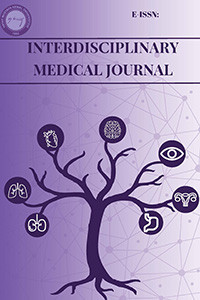ALOPESİ AREATADA TOPİKAL PSORALEN VE ULTRAVİOLE A FOTOKEMOTERAPİSİNİN ETKİNLİĞİNİN DEĞERLENDİRİLMESİ
Alopesi areata, fototerapi, fotokemoterapi
Evaluation of the efficacy of topical psoralen and ultraviolet A photochemotherapy in alopecia areata
Alopecia areata, phototherapy, photochemotherapy,
___
- Oğuz O. Alopesi Areata. In: Tüzün Y, Gürer MA, Serdaroğlu S, Oğuz O, Aksungur V,
- eds. Dermatoloji, 3.cü baskı İstanbul, Nobel Tıp Kitabevleri, 2008:1318-1324.
- Paus R, Olsen EA, Messenger AG. Hair Growth Disorders. In: Wolff K, Goldsmith LA,
- Katz SI, Gilchrest BA, Paller AS, Leffell DJ, eds. Fitzpatricks’s Dermatology in General
- Medicine. 7th eds. New York, McGraw-Hill, 2008:762-765.
- Wasserman D, Guzman-Sanchez DA, Scott K, McMichael A. Alopecia areata. Int J
- Dermatol. 2007;46(2):121-131.
- Mitchell AJ, Balle MR. Alopecia areata. Dermatol Clin. 1987;5(3):553-564.
- Healy E, Rogers S. PUVA treatment for alopecia areata – does it work? A retrospective
- review of 102 cases. Br J Dermatol. 1993;129:42-44.
- Taylor CR, Hawk JLM. PUVA treatment of alopecia areata partialis, totalis and
- universalis: Audit of 10 years’ experience at StJohn’s Institute of Dermatology. Br J
- Dermatol. 1995;133:914-918.
- van der Schaar WW, Sillevis Smith JH. An evaluation of PUVA-therapy for
- alopeciaareata. Dermatologica 1984;168:250-252.
- Whitmont KJ, Cooper AJ. PUVA treatment of alopecia areata totalis and universalis: a
- retrospective study. Australas J Dermatol 2003;44:106-109.
- Sahin S, Yalçın B, Karaduman A. PUVA treatment for alopecia areata. Experience in a
- Turkish population. Dermatology 1998;197:245-247.
- Weissmann I, Hofman C, Wagner G, Plewig G, Braun-Falco O. PUVA-therapy for
- alopecia areata. Arch Dermatol Res 1978;262:233-236.
- Broniarczyk-Dyla G, Wawrzycka-Kaflik A, Dubla-Berner M, Prusinska-Bratos M. Effects
- of psoralen-UV-A-Turban in alopecia areata. Skinmed. 2006;5(2):64-68.
- Mohamed Z, Bhouri A, Jallouli A, Fazaa B, Kamoun MR, Mokhtar I. Alopecia areata
- treatment with a phototoxicdose of UVA and topical 8-methoxypsoralen. J Eur Acad
- Dermatol Venereol 2005;19:552-555.
- Kamel MM, Salem SA, Attia HH. Successful treatment of resistant alopecia areata with a
- phototoxic dose of ultraviolet A after topical 8-methoxy psoralen application.
- Photodermatol Photoimmunol Photomed. 2011;27(1):45-50.
- Madani S, Shapiro J.Alopecia areata update. J Am Acad Dermatol 2000;42:549-566
- Yayın Aralığı: Yılda 3 Sayı
- Başlangıç: 2023
- Yayıncı: Hatay Mustafa Kemal Üniversitesi Tıp Fakültesi Dekanlığı
Savaş Sarıkaya, Şafak Şahin, Lütfi Akyol, Turan Aktaş, Yavuz İntepe, Elif Börekçi, Yunus Yılmaz
BİRİNCİ TRİMESTERDE SAPTANAN İKİ AKRANİ OLGUSU
Nesrin ATCI, Ayşe GÜLER, Hakan YERAL, Atilla KARATEKE, Hanifi BAYAROĞLU
DÜŞME HİKAYESİ BULUNAN BİR ATEŞLİ SİLAH YARALANMA OLGUSU; OLAY YERİ İNCELEMENİN ÖNEMİ
Hüseyin KAFADAR, Safiye KAFADAR
GENDEN TEDAVİYE YENİ YAKLAŞIMLAR: KODLAMAYAN NÜKLEİK ASİTLER
Hasret ECEVİT, Sedat MOTOR, Müzeyyen İZMİRLİ
Pınar Özuğuz, Seval Kaçar, Serap Polat, Sena Ulu, Şemsettin Karaca
ALOPESİ AREATADA TOPİKAL PSORALEN VE ULTRAVİOLE A FOTOKEMOTERAPİSİNİN ETKİNLİĞİNİN DEĞERLENDİRİLMESİ
Bilge Şen, Özlem Ekiz, Emine Rifaioğlu, Tuğba Şen, Asena Doğramacı
BÜYÜK SAFEN VEN YETMEZLİĞİNDE ENDOVENÖZ LAZER ABLASYON TEDAVİSİ TECRÜBELERİMİZ
Özgür Bulut, Ümit Halıcı, Atilla Kanca, Soner Sanioğlu
ANESTEZİDE MERKEZİ VENÖZ KATETERİZASYONDA ULTRASONOGRAFİ KULLANALIM MI? (ÜÇ OLGU SUNUMU)
Kasım TUZCU, Murat KARCIOĞLU, İşıl DAVARCI, Onur KOYUNCU, Sedat HAKİMOĞLU, Orcan HABİB, Çağla AKKURT, Selim TURHANOĞLU
